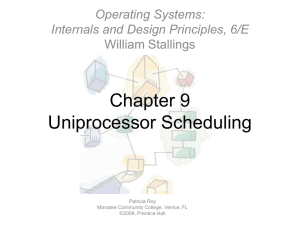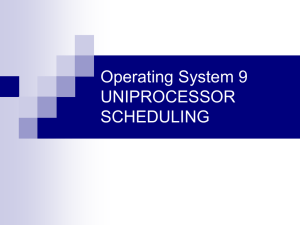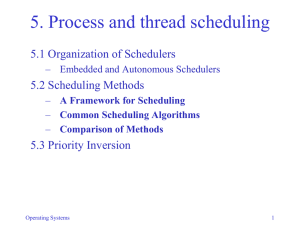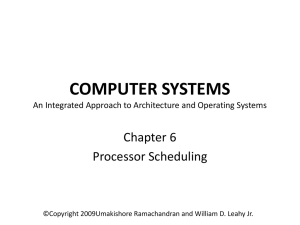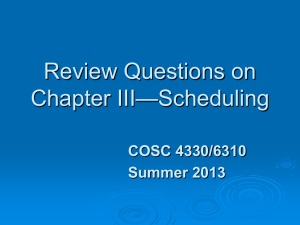scheduling
advertisement
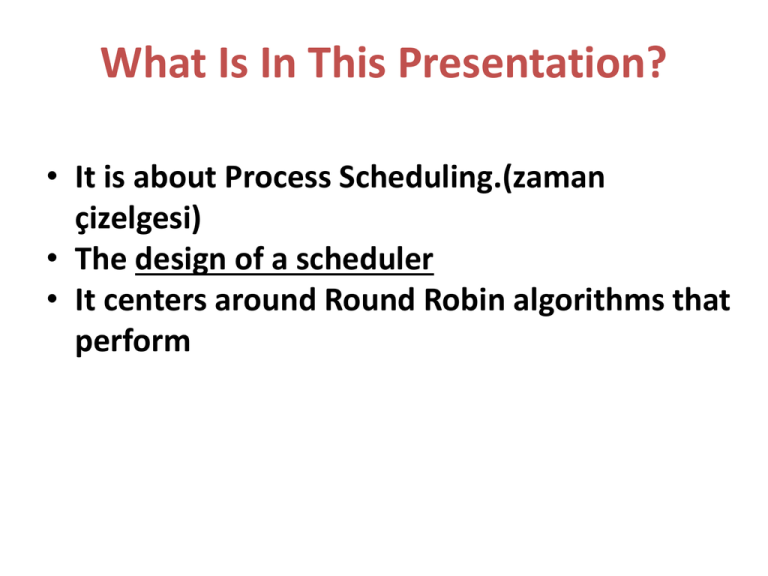
What Is In This Presentation? • It is about Process Scheduling.(zaman çizelgesi) • The design of a scheduler • It centers around Round Robin algorithms that perform start In computer science, scheduling is the method by which threads, processes or data flows are given access to system resources (e.g. processor time, communications bandwidth). scheduling This is usually done to load balance a system effectively or achieve a target quality of service. • The need for a scheduling algorithm arises from the requirement for most modern systems • to perform multitasking (execute more than one process at a time) • and multiplexing (transmit multiple flows simultaneously). The scheduler The scheduler is concerned mainly with: • Throughput(üretilen iş) - The total number of processes that complete their execution per time unit. • Latency (gecikme), specifically: – Turn-around time (dönüş süresi)- total time between submission of a process and its completion. – Response time (tepki süresi)- amount of time it takes from when a request was submitted until the first response is produced. • Fairness / Waiting Time(bekleme süresi) - Equal CPU time to each process (or more generally appropriate times according to each process' priority). It is the time for which the process remains in the ready queue. The scheduler • The scheduler assigns a fixed time unit per process, and cycles through them. • RR scheduling involves extensive overhead, especially with a small time unit. • Balanced throughput between FCFS and SJF, shorter jobs are completed faster than in FCFS and longer processes are completed faster than in SJF. • Poor average response time, waiting time is dependent on number of processes, and not average process length. • Because of high waiting times, deadlines are rarely met in a pure RR system. • Starvation can never occur, since no priority is given. • Order of time unit allocation is based upon process arrival time, similar to FCFS. There is no universal “best” scheduling algorithm, and many operating systems use extended or combinations of the scheduling algorithms above. Windows uses a multilevel feedback queue, a combination of -fixed priority preemptive scheduling, - round-robin, - and first in first out. In this system, threads can dynamically increase or decrease in priority depending on if it has been serviced already, or if it has been waiting extensively. Every priority level is represented by its own queue, with roundrobin scheduling amongst the high priority threads and FIFO among the lower ones. The algorithm used may be as simple as round-robin in which each process is given equal time (for instance 1 ms, usually between 1 ms and 100 ms) in a cycling list. So, process A executes for 1 ms, then process B, then process C, then back to process A. Scheduling disciplines • Scheduling disciplines are algorithms used for distributing resources among parties which simultaneously and asynchronously request them Scheduling disciplines are used • in routers (to handle packet traffic) as well as • in operating systems (to share CPU time among both threads and processes), • disk drives (I/O scheduling), • printers (print spooler), most embedded systems, etc. Scheduling Goals • Maximize throughput and resource utilization. – Need to overlap CPU and I/O activities. • Minimize response time, waiting time and turnaround time. • Share CPU in a fair way. • May be difficult to meet all these goals-sometimes need to make tradeoffs(An exchange that occurs as a compromise). Purpose of scheduling The main purposes of scheduling algorithms are to minimize resource starvation and to ensure fairness amongst the parties utilizing the resources. Note :- Starvation occurs if a low priority process never runs. The ssolution is: build aging into a variable priority. Scheduling deals with the problem of deciding which of the outstanding requests is to be allocated resources. There are many different scheduling algorithms One of them are Round Robin Algorithem Round-robin scheduling Round-robin (RR) is one of the algorithms employed by process and network schedulers in computing. As the term is generally used, • time slices are assigned to each process in equal portions and in circular order, • handling all processes without priority (also known as cyclic executive). • Round-robin scheduling is simple, easy to implement, and starvation-free. Round-robin scheduling cont. • Round-robin scheduling can also be applied to other scheduling problems, such as data packet scheduling in computer networks. • It is an Operating System concept. • The name of the algorithm comes from the round-robin principle known from other fields, where each person takes an equal share of something in turn. RR Process scheduling In order to schedule processes fairly, a roundrobin scheduler generally employs time-sharing, giving each job a time slot or quantum[1] (its allowance of CPU time), and interrupting the job if it is not completed by then. The job is resumed next time a time slot is assigned to that process. In the absence of timesharing, or if the quanta were large relative to the sizes of the jobs, a process that produced large jobs would be favoured over other processes. ROUND ROBIN: Use a timer to cause an interrupt after a predetermined time. Preempts (have precedence over) if task exceeds it’s quantum. Definitions: – Context Switch -Changing the processor from running one task (or process) to another. Implies changing memory. – Processor Sharing Use of a small quantum such that each process runs frequently at speed 1/n. – Reschedule latency How long it takes from when a process requests to run, until it finally gets control of the CPU. Choosing a time quantum Choosing a time quantum – Too short - inordinate (excessive) fraction of the time is spent in context switches. – Too long - reschedule latency is too great. If many processes want the CPU, then it's a long time before a particular process can get the CPU. This then acts like FCFS. – Adjust so most processes won't use their slice. As processors have become faster, this is less of an issue. Round Robin (RR) – FCFS + preemptive scheduling. • First Come First Served (FCFS)-Scheduler selects the process at the head of the ready queue; typically non-preemptive – Ready queue is treated as a circular queue. – Each process gets the CPU for a time quantum (or time slice), typically 10 - 100 ms. – A process runs until it blocks, terminates, or uses up its time slice. Example – Example: Assuming a time quantum of 4 ms, what’s the average waiting time? • Issue: What’s the right value for the time quantum? • Too long => poor response time • Too short => poor throughput • RR pros & cons: + Works well for short jobs; typically used in timesharing systems. – High overhead due to frequent context switches. – Increases average waiting time, especially if CPU bursts are the same length and need more than one time quantum. Scheduling Algorithms CPU SCHEDULING EXAMPLE DATA: Process Arrival Time 0 1 2 3 1 2 3 4 Note: Example violates rules for quantum size since most processes don’t finish in one quantum. Service Time 8 4 9 5 Round Robin, quantum = 4, no priority-based preemption P1 0 P2 4 P3 8 P4 12 P1 16 P3 20 P4 24 P3 25 Average wait = ( (20-0) + (8-1) + (26-2) + (25-3) )/4 = 74/4 = 18.5 5: CPU-Scheduling 17 26 Example As an Example From networks • Round robin DNS & DDNS (Dynamic DNS) is often used to load balance requests between a number of Web servers. For example, a company has one domain name and three identical copies of the same web site residing on three servers with three different IP addresses. 5: CPU-Scheduling 18 Weighted round robin • Weighted round robin (WRR) is a scheduling discipline • specifically for scheduling in ATM networks using fixed size packets (cells). • In the more general case of IP networks with variable size packets, in order to approximate GPS(Generalized processor sharing) the weight factors must be normalized. Service is shared between all non-empty classes in the same ratio as the weight factors (positive values for each service class). 5: CPU-Scheduling 19 Deficit Round Robin • Deficit Round Robin (DRR), also Deficit Weighted Round Robin (DWRR), is a scheduling algorithm for the network scheduler. WRR serves every non-empty queue where as DRR serves packets at the head of every non-empty queue whose deficit counter is greater than the packet's size at the head of the queue (HoQ). If the deficit counter is lower, • then the queue is skipped (HoQ packet is not served) • and its credit is increased by some given value called quantum. • This increased value is used to calculate the deficit counter the next time around when the scheduler examines this queue for serving its head-of-line packet. If the queue is served, then the Credit is decremented by the size of packet being served. 5: CPU-Scheduling 20 What if? • What happens if the time allocated in a Round Robin Scheduling is very large? And what happens if the time allocated is very low? Ans: It results in a FCFS scheduling, that means Scheduler selects the process at the head of the ready queue; typically non-preemptive If time is too low, the processor through put is reduced. More time is spent on context switching Operating System Preemption Algorithm Amiga OS Yes Prioritized Round-robin scheduling FreeBSD Yes Multilevel feedback queue Linux pre-2.6 Yes Multilevel feedback queue Linux 2.6-2.6.23 Summary Yes O(1) scheduler Linux post-2.6.23 Yes Completely Fair Scheduler Mac OS pre-9 None Cooperative Scheduler Mac OS 9 Some Preemptive for MP tasks, Cooperative Scheduler for processes and threads Mac OS X Yes Multilevel feedback queue NetBSD Yes Multilevel feedback queue Solaris Yes Multilevel feedback queue Windows 3.1x None Cooperative Scheduler Windows 95, 98, Me Half Preemptive for 32-bit processes, Cooperative Scheduler for 16-bit processes Windows NT (including 2000, XP, Vista, 7, and Yes Server) Multilevel feedback queue
